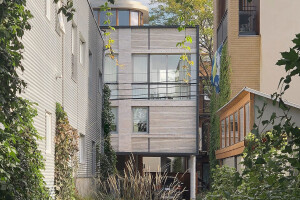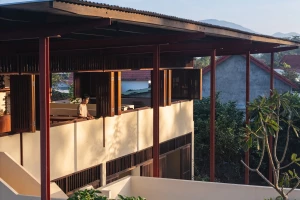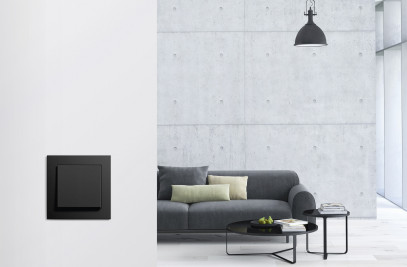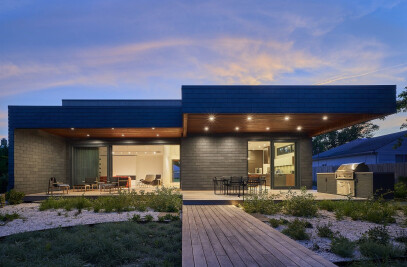Montreal-based architectural practice Ædifica has completed Cité Angus II, the second phase of a residential development in the Technopôle Angus, an urban regeneration project in the suburbs of Montreal, Quebec. Cité Angus II comprises 88 condominium units, including two small first-floor commercial units facing a public square. The Technopôle Angus is Quebec’s first mixed eco-district: completed in 2023, the eco-friendly Cité Angus II development is now striving for LEED Gold certification.
The Technopôle Angus features a mix of office and commercial properties, residential buildings, green spaces, and public squares. First conceived in the late 1990s, the urban regeneration project’s site was once home to the Canadian Pacific Railway’s largest North American factory (opened in 1904, the “CPR Angus Shops” were decommissioned in 1992).
Cité Angus II (also known as Block 4) sits on a cramped plot with an atypical shape. Ædifica approached the project’s development by prescribing a number of guidelines: “density, diversity of residential typologies responding to evolving needs, access to natural light and quality views, biophilia, and the integration of outdoor spaces.” In terms of densification, the studio set about achieving a critical density to enable the implementation of strategies that would help to reduce energy use and develop community facilities as part of a socioecological transition. In essence, the project’s two main goals are centered around sustainability and a good quality of life for residents. “The project adheres to the principles of land development based on well-being and sharing,” says Ædifica.
The residential building consists of two volumes separated by a landscaped courtyard with a pedestrian walkway — the shared space is designed to encourage social interaction and chance encounters without compromising the project’s density objective. In the center of the courtyard, an impressive architectural spiral staircase connects the two volumes via a network of external passageways, allowing many residents to access their homes via the central space. With its copper-colored cladding, the spiral staircase echoes the spiral staircase exits that are typical of Montreal backyards.
Ædifica designed the building envelope with different facade treatments. On the exterior-facing section of the building that overlooks Parc Jean-Duceppe (Montreal’s third-largest park), a monochromatic metal mesh, inspired by the district's industrial heritage, is fitted close to the envelope (marked in blue in the diagram below). This park-facing facade is punctuated by a number of protruding balconies placed in alternating rows. On the building’s other outward-facing facades (marked in green), the same metal mesh skin detaches from the face of the exterior wall, making way for a series of continuous corridors and balconies. This double-skin acts as a balcony railing and provides residents with privacy.

On the inner courtyard-facing facades (marked in red), Ædifica applied a light-colored metallic cladding to the building envelope and a copper-colored cladding on the walkways, adding a sense of dynamism to the space.
The apartment units are designed to offer both versatility and adaptability, reflecting a diversity of individual and family requirements. Single-story and duplex apartments are accessible via the building’s exterior corridors or interior corridors; some units are both exterior- and interior-facing. “All units been developed with a constant concern for equity, accessibility, and inclusion, and for access to a healthy, efficient, and sustainable environment,” says Ædifica.
The building’s heating and cooling system is connected to an energy loop: the “Îlot Central” ecosystem. This loop links each of the buildings in the Technopôle Angus, exchanging hot and cold air and reducing energy consumption by around 40 percent. Moreover, a water management system reuses rainwater to flush toilets and irrigate gardens and green spaces. (The Technopôle Angus eco-district is Quebec’s first certified LEED Platinum Neighborhood Development.) Cité Angus II also incorporates a number of green roofs, helping to minimize energy consumption and temper the urban heat island effect.
Net Surface Area: 38,000 square meters (409,029 square feet)




























































